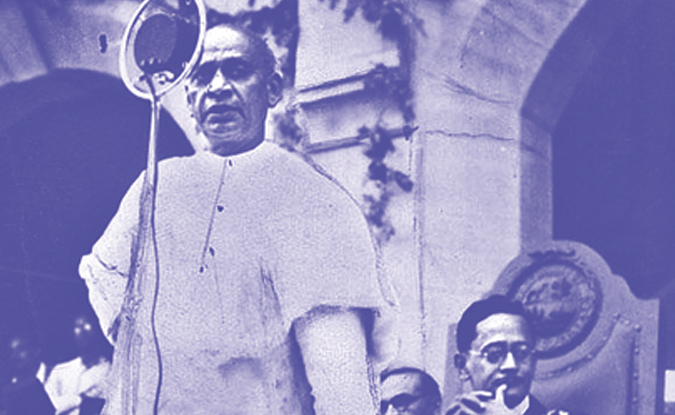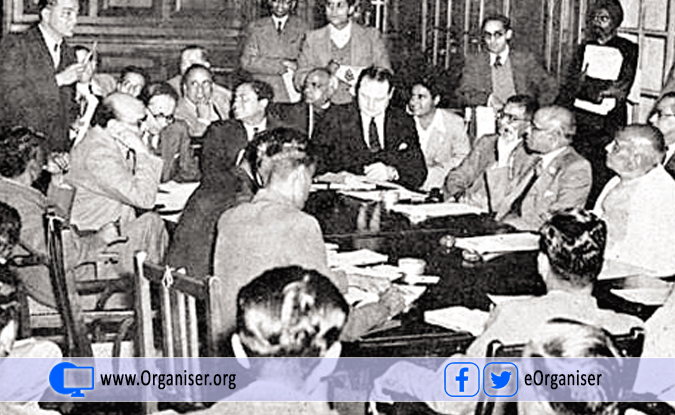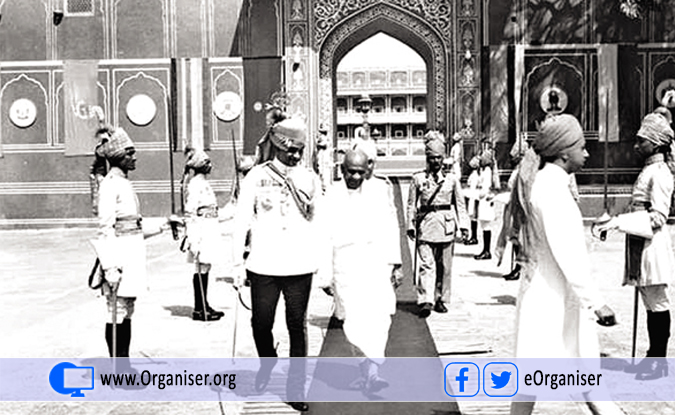The political unity of India was the handiwork of Sardar Patel. Fortunately, he was not romantic like Nehru, and therefore he assured the paramountcy of democracy and the Indian State over all other interests and considerations
Mahatma Gandhi told Sardar Vallabhbhai Patel that, “The problem of the States is so difficult that you alone can solve it.” Patel became the knight in the shining armour when the country faced the biggest problem left by the British while departing India- more than 550 Princely States. The ‘iron man of India’, Sardar Patel was valued on the one hand for being politically astute and on the other hand for his pragmatic acumen, necessary to bring together more than 500 bits and pieces of royal territories into the fold of the Indian Union.

Sardar Patel addressing a gathering of Indian Princes
Article 1 of the Constitution states that ‘India, that is, Bharat, shall be a Union of States.’ No one can claim greater credit for the political unity of the country after the lapse of the Colonial State than Sardar Patel, ably assisted by VP Menon (Constitutional Adviser to Lord Mountbatten).
In 1947, Princely States numbering 555 covered 48 per cent of the area of pre-Independent India and constituted 28 per cent of its population. Legally, the Princely States were not a part of British India and the people of these states were not treated as British subjects. But, in reality, they were completely subordinate to the British Crown.

Sardar Patel (seen sitting at the centre-right) at a press conference in New Delhi reviewing constitutional process of the Indian States, January 29, 1948
The Indian Independence Act, 1947, provided for the lapse of paramountcy of the British Crown over the Indian states. Each ruler had the option to accede to the dominion of India or Pakistan or continue as an independent sovereign mini-state. The rulers were often seen, perhaps rightly, as lackeys and stooges of the British Empire. Even in the “mutiny” of 1857, many of them actively assisted the British. Lord Canning acknowledged their role as “breakwaters in the storm which would have swept over us in one great wave.”
Realpolitik of Sardar
Incidentally, Patel was also the first Congress statesman to have supported Partition as the most viable solution to Muslim separatist movement in India. On June 27, 1947, he was made the Minister in charge of the new States Department. He, along with his secretary Menon was given the task of negotiating with the Princes. Between them, they produced a draft instrument of accession which would be signed by the Princes as an agreement to transfer control of the defence, foreign affairs and communications to the Congress Government.

Sardar Patel with the Maharaja of Jaipur (Kulwant Roy collections)
Patel often invoked the patriotism of the Princes in his attempt to convince them to join India. On other occasions, he reminded them of the possibility of anarchy on the event of their refusal to join. He also introduced the concept of ‘Privy Purses’ as a payment to be made to the families of the Princes for their agreement to integrate with India.
The negotiation over the instrument of accession in the case of each Princely State is an intriguing story. All the varying craft of diplomacy were used! Constitutional negotiations, promising benefits, stroking patriotism, threats and even action by armed forces had to be used to consolidate the unity of India.
Nizam’s Hyderabad and “Operation Polo”
The chaos over the rumours that Hyderabad was arming itself with support from the Portuguese administration in Goa and Pakistan led to communal clashes and added to the tension in the State. Nizam was getting ready to side with Pakistan.The idea of Hyderabad arming itself aided by Pakistan did not go down well with the Indian Government. Sardar Patel described the idea of an independent Hyderabad as “an ulcer in the heart of India which needed to be removed surgically.” It was when talks between India and Hyderabad started, and India decided to annex Hyderabad. This operation was named “Operation Polo”.Though it was only a five-day war that began on September 13 and lasted till September 18, it was significant as the Indian Army took over a powerful state and Hyderabad was attached to India.
Indian Princes were a basket of diversity. There was some who could be won over simply through the offer of the Privy Purse, and then there were others who demanded to retain their palaces and titles in return for acceding to India. It was the case with the Maharaja of Chhota Hazari, who would hold on to his title and pass it on to his son as wellConstitutional negotiations, promising benefits, stroking patriotism, threats and even action by armed forces were used to unite India
A particularly interesting and challenging case of negotiating with the Princes was offered by the ruler of Jodhpur. The Maharaja of Jodhpur had made up his mind to join Pakistan instead of India. Menon met him at the Viceroy’s house on realising the problems it could lead to. Menon frantically looked out for Mountbatten to persuade the stubborn Prince. Mountbatten is believed to have coaxed the young ruler, by reminding him of the disappointment his deceased father would have experienced on hearing his decision. He finally left the two together, promising the prince that Patel and Menon would be tolerant towards his personal demands once he decided to join India. Once left with Menon, the ruler signed the instrument of accession, and soon after revealed a miniature pistol that he pointed at Menon stating loudly, “I am not giving in to your threats.” However, the pistol was soon confiscated by Mountbatten.
Kashmir had been taken away from Patel’s charge by Nehru under Sheikh Abdullah’s pressure. Had he been given the charge of Kashmir this issue would have been most probably solved years ago or would not have created as much problem as we are facing todayThe tireless efforts of Patel and Menon resulted in the Princes agreeing to the dissolution of their respective states. They surrendered several villages, thousands of acres of scattered jagir land’s, palaces, museums, buildings, aircraft, and cash balances and investments amounting to Rs 77 crore. Also, there was the railway system of about 12,000 miles which the States surrendered to the Centre without receiving any compensation.
In consideration of their agreeing to integrate with India, the Princes were to be paid a Privy Purse, which was approximately 8.5 per cent of the annual revenue of each Princely State. The amounts varied from Rs 43 lakh a year to the Nizam of Hyderabad to just Rs 192 a year to the ruler of Katodia. Of the 555 rulers, 398 were to get less than Rs 50,000 a year. The total cost to the Indian exchequer in 1947 was Rs 6 crore, which was to be progressively reduced. At the time of abolition in 1970, the total amount payable to all the erstwhile Princes was just Rs 4 crore a year.
Diplomatic Manoeuvres par excellence
Through his diplomatic manoeuvres, Sardar Patel secured accession of all the States before August 15, 1947, before they could be made independent at par with India and Pakistan, thereby gaining equal status. As the day of independence drew closer, Patel decided on using force where necessary, for instance in the case of the Maharaja of Orissa. The exceptions were those of Junagarh and Hyderabad- Kashmir too, but those were under Nehru’s charge. Junagarh was a Princely State situated in the Kathiawad peninsula in south-west Gujarat. This princely state was ruled by a Muslim Nawab Mohbat Khan though the majority of its population was Hindu. Though the land boundary of Junagarh was not attached to Pakistan, the Nawab of Junagarh argued that Pakistan could be reached from Junagarh through sea route. Nawab MohbatKhan and his Dewan Shahnawaj Bhutto dreamt of merging Junagarh with Pakistan. However, they were to deal with a nationalist and patriot like Patel, and not some other internationalist like Nehru who could mess up things as he did in Kashmir.
Kashmir had been taken away from Patel’s charge by Nehru under Sheikh Abdullah’s pressure. Had he been given the charge of Kashmir this issue would have been most probably solved years ago or would not have created as much problem as we are facing today. In his eulogy, delivered the day after Patel’s death, Sir Girija Shankar Bajpai, the Secretary-General of the Ministry of External Affairs, paid tribute to “a great patriot, a great administrator and a great man. Sardar Patel was all three, a rare combination in any historic epoch and any country.”














Comments